Egypt
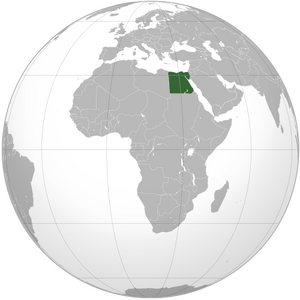
Egypt (pronounced /ˈiːdʒɪpt/) is a country mainly in North Africa, with the Sinai Peninsula forming a land bridge in Southwest Asia. Thereby, Egypt is a transcontinental country, and is considered to be a major power in North Africa, Mediterranean Region, African continent, Nile Basin, Islamic World and the Red Sea. Covering an area of about 1,010,000 square kilometers (390,000 sq mi), Egypt is bordered by the Mediterranean Sea to the north, the Gaza Strip and Israel to the northeast, the Red Sea to the east, Sudan to the south and Libya to the west.
Egypt is one of the most populous countries in Africa and the Middle East. The great majority of its estimated 77.4 million live near the banks of the Nile River, in an area of about 40,000 square kilometers (15,000 sq mi), where the only arable agricultural land is found. The large areas of the Sahara Desert are sparsely inhabited. About half of Egypt's residents live in urban areas, with most spread across the densely populated centres of greater Cairo, Alexandria and other major cities in the Nile Delta.
Egypt is famous for its ancient civilization and some of the world's most famous monuments, including the Giza pyramid complex and its Great Sphinx. The southern city of Luxor contains many ancient artifacts, such as the Karnak Temple and the Valley of the Kings. Egypt is widely regarded as an important political and cultural nation of the Middle East.
Egypt possesses one of the most developed and diversified economies in the Middle East, with sectors such as tourism, agriculture, industry and service at almost equal rates in national production.
Captain Ahmed Ibn Salid, Commanding officer of the USS Rosenante is from Egypt.
Identity[edit]
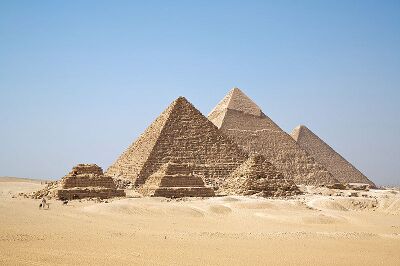
The Nile Valley was home to one of the oldest cultures in the world, spanning three thousand years of continuous history. When Egypt fell under a series of foreign occupations after 343 BC, each left an indelible mark on the country's cultural landscape. Egyptian identity evolved in the span of this long period of occupation to accommodate, in principle, two new religions, Islam and Christianity; and a new language, Arabic, and its spoken descendant, Egyptian Arabic.
The degree to which Egyptians identify with each layer of Egypt's history in articulating a sense of collective identity can vary. Questions of identity came to fore as Egypt sought to free itself from foreign occupation for the first time in two thousand years. Three chief ideologies came to head: ethno-territorial Egyptian nationalism, secular Arab nationalism and pan-Arabism, and Islamism. Egyptian nationalism predates its Arab counterpart by many decades, having roots in the nineteenth century and becoming the dominant mode of expression of Egyptian anti-colonial activists and intellectuals until the early 20th century. Arab nationalism reached a peak under Nasser but was again relegated under Sadat; meanwhile, the ideology espoused by Islamists such as the Muslim Brotherhood is present in small segments of the lower-middle strata of Egyptian society.
The work of early nineteenth-century scholar Rifa'a et-Tahtawi led to the Egyptian Renaissance, marking the transition from Medieval to Early Modern Egypt. His work renewed interest in Egyptian antiquity and exposed Egyptian society to Enlightenment principles. Tahtawi co-founded with education reformer Ali Mubarak a native Egyptology school that looked for inspiration to medieval Egyptian scholars, such as Suyuti and Maqrizi, who themselves studied the history, language and antiquities of Egypt.
Egypt's renaissance peaked in the late 19th and early 20th centuries through the work of people like Muhammad Abduh, Ahmed Lutfi el-Sayed, Muhammad Loutfi Goumah, Tawfiq el-Hakim, Louis Awad, Qasim Amin, Salama Moussa, Taha Hussein and Mahmoud Mokhtar. They forged a liberal path for Egypt expressed as a commitment to personal freedom, secularism and faith in science to bring progress
Geography[edit]
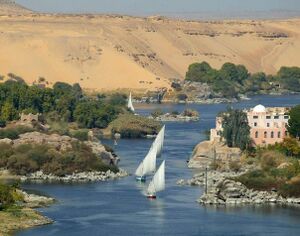
At 1,001,450 square kilometers (386,660 sq mi), Egypt is about the same size as all Central America, twice the size of the Iberian Peninsula, four times the size of the British Isles, and the combined size of the old US states of Texas and California.
Nevertheless, due to the aridity of Egypt's climate, population centres are concentrated along the narrow Nile Valley and Delta, meaning that about 99% of the population uses only about 5.5% of the total land area.
Egypt is bordered by Libya to the west, Sudan to the south, and by the Gaza Strip and Israel to the east. Egypt's important role in geopolitics stems from its strategic position: a transcontinental nation, it possesses a land bridge (the Isthmus of Suez) between Africa and Asia, which in turn is traversed by a navigable waterway (the Suez Canal) that connects the Mediterranean Sea with the Indian Ocean by way of the Red Sea. Although since the advent of transporters and space flight these factors are no longer strategically important.
Apart from the Nile Valley, the majority of Egypt's landscape is a desert. The winds blowing can create sand dunes more than 100 feet (30 m) high. Egypt includes parts of the Sahara Desert and of the Libyan Desert. These deserts were referred to as the "red land" in ancient Egypt, and they protected the Kingdom of the Pharaohs from western threats.
Towns and cities include Alexandria, one of the greatest ancient cities, Aswan, Asyut, Cairo, the modern Egyptian capital, El-Mahalla El-Kubra, Giza, the site of the Pyramid of Khufu, Hurghada, Luxor, Kom Ombo, Port Safaga, Port Said, Sharm el Sheikh, Suez, where the Suez Canal is located, Zagazig, and Al-Minya. Oases include Bahariya, el Dakhla, Farafra, el Kharga and Siwa. Protectorates include Ras Mohamed National Park, Zaranik Protectorate and Siwa.
Climate[edit]
Egypt does not receive much rainfall except in the winter months. South of Cairo, rainfall averages only around 2 to 5 mm (0.1 to 0.2 in) per year and at intervals of many years. On a very thin strip of the northern coast the rainfall can be as high as 410 mm (16.1 in), with most of the rainfall between October and March. Snow falls on Sinai's mountains and some of the north coastal cities such as Damietta, Baltim, Sidi Barrany, etc. and rarely in Alexandria, frost is also known in mid-Sinai and mid-Egypt. it is only with the implementation of weather control satellites that rain patterns have been altered to accommodate a larger more steady climactic rainfall.
Temperatures average between 80 °F (27 °C) and 90 °F (32 °C) in summer, and up to 109 °F (43 °C) on the Red Sea coast. Temperatures average between 55 °F (13 °C) and 70 °F (21 °C) in winter. A steady wind from the northwest helps hold down the temperature near the Mediterranean coast. The Khamaseen is a wind that blows from the south in Egypt in spring, bringing sand and dust, and sometimes raises the temperature in the desert to more than 100 °F (38 °C).
Every year, a predictable flooding of the Nile replenishes Egypt's soil. This gives the country consistent harvest throughout the year. Many know this event as The Gift of the Nile.
Religion[edit]
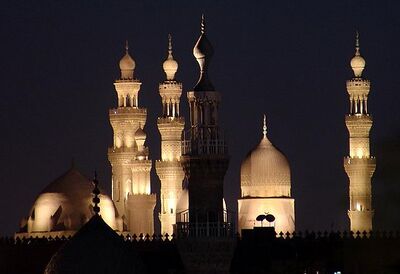
Egypt is a predominantly Muslim country with Islam as its accepted regional religion. Between 80% and 94% of the local populace are identified as Muslim. Almost the entire population of Muslims are Sunni. A significant number of Muslim Egyptians also follow native Sufi orders, and there is a minority of Shi'a.
There is a large minority of Christians in Egypt, who make up the remainder of the population (between 6% and 20%). Over 90% of Egyptian Christians belong to the native Coptic Orthodox Church of Alexandria. Other native Egyptian Christians are adherents of the Coptic Catholic Church, the Evangelical Church of Egypt and various other Protestant denominations. Non-native Christian communities are largely found in the urban regions of Cairo and Alexandria.
There is also a small, but nonetheless historically significant, non-immigrant Bahá'í population of around 2000, and an even smaller community of Jews of about 200, then a tiny number of Egyptians who identify as atheist and agnostic. The non-Sunni, non-Coptic communities range in size from several hundreds to a few thousand. Millions of Egyptians follow the Christian faith as members of the Coptic Orthodox Church of Alexandria.
According to the original constitution of Egypt, any new legislation must at least implicitly agree with Islamic law; however, the constitution bans political parties with a religious agenda. Egypt hosts two major religious institutions. Al-Azhar University, founded in 970 A.D by the Fatimids as the first Islamic University in Egypt and the main Egyptian Church the Coptic Orthodox Church of Alexandria established in the middle of the 1st century by Saint Mark.
Religion plays a central role in most Egyptians' lives, The Adhan (Islamic call to prayer) that is heard five times a day has the informal effect of regulating the pace of everything from business to media and entertainment. Cairo is famous for its numerous mosque minarets and is justifiably dubbed "the city of 1,000 minarets", with a significant number of church towers. This religious landscape has been marred by a history of religious extremism, recently witnessing a 2006 judgement of Egypt's Supreme Administrative Court, which made a clear legal distinction between "recognized religions" (i.e., Islam, Christianity, and Judaism) and all other religious beliefs. This ruling effectively delegitimizes and forbids practice of all but the three Abrahamic religions.
This judgment had made it necessary for non-Abrahamic religious communities to either commit perjury or be denied Egyptian identification cards (see Egyptian identification card controversy), until a 2008 Cairo court case ruled that unrecognized religious minorities may obtain birth certificates and identification documents, so long as they omit their religion on court documents.
In 2002, under the Mubarak Government, Coptic Christmas (January the 7th) was recognized as an official holiday, though Copts report being minimally represented in law enforcement, state security and public office, and of being discriminated against in the workforce on the basis of their religion. The Coptic community, as well as several human rights activists and intellectuals, maintain that the number of Christians occupying Government posts is not proportional to the number of Copts in Egypt.
Culture[edit]
Egyptian culture has six thousand years of recorded history. Ancient Egypt was among the earliest civilizations and for millennia, Egypt maintained a strikingly complex and stable culture that influenced later cultures of Europe, the Middle East and other African countries. After the Pharaonic era, Egypt itself came under the influence of Hellenism, Christianity, and Islamic culture. Today, many aspects of Egypt's ancient culture exist in interaction with newer elements, including the influence of modern Western culture, itself with roots in ancient Egypt.
Egypt's capital city, Cairo, is Africa's largest city and has been renowned for centuries as a center of learning, culture and commerce. Egypt has the highest number of Nobel Laureates in Africa and the Arab World. Some Egyptian born politicians were or are at the helm of major international organizations like Boutros Boutros-Ghali of the United Nations and Mohamed ElBaradei of the IAEA.
Egypt is a recognized cultural trend-setter of the Arabic-speaking world, and contemporary Arab culture is heavily influenced by Egyptian literature, music, film and television. Egypt gained a regional leadership role during the 1950s and 1960s, which gave a further enduring boost to the standing of Egyptian culture in the Arab world.
Art and architecture[edit]
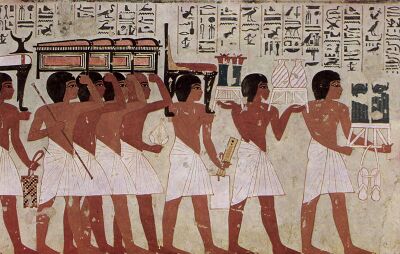
Eighteenth dynasty painting from the tomb of Theban governor Ramose in Deir el-Madinah.
The Egyptians were one of the first major civilizations to codify design elements in art and architecture. The wall paintings done in the service of the Pharaohs followed a rigid code of visual rules and meanings. Egyptian civilization is renowned for its colossal pyramids, colonnades and monumental tombs. Well-known examples are the Pyramid of Djoser designed by ancient architect and engineer Imhotep, the Sphinx, and the temple of Abu Simbel. Modern and contemporary Egyptian art can be as diverse as any works in the world art scene, from the vernacular architecture of Hassan Fathy and Ramses Wissa Wassef, to Mahmoud Mokhtar's famous sculptures, to the distinctive Coptic iconography of Isaac Fanous.
The Cairo Opera House serves as the main performing arts venue in the Egyptian capital. Egypt's media and arts industry has flourished since the late nineteenth century, today with more than thirty satellite channels and over one hundred motion pictures produced each year. Cairo has long been known as the "Hollywood of the Middle East;" its annual film festival, the Cairo International Film Festival, has been rated as one of 11 festivals with a top class rating worldwide by the International Federation of Film Producers' Associations. To bolster its media industry further, especially with the keen competition from the Persian Gulf Arab States and Lebanon, a large media city was built. Some Egyptian-born actors, like Omar Sharif, have achieved worldwide fame.
Literature[edit]
Literature is an important cultural element in the life of Egypt. Egyptian novelists and poets were among the first to experiment with modern styles of Arabic literature, and the forms they developed have been widely imitated throughout the Middle East. The first modern Egyptian novel Zaynab by Muhammad Husayn Haykal was published in 1913 in the Egyptian vernacular. Egyptian novelist Naguib Mahfouz was the first Arabic-language writer to win the Nobel Prize in Literature. Egyptian women writers include Nawal El Saadawi, well known for her feminist activism, and Alifa Rifaat who also writes about women and tradition.
Vernacular poetry is perhaps the most popular literary genre among Egyptians, represented by the works of Ahmed Fouad Negm (Fagumi), Salah Jaheen and Abdel Rahman el-AbnudiIn their belief, boats were used by the dead to accompany the sun around the world, as Heaven was referred to as “Upper Waters”. In Egyptian mythology, every night the serpentine god Apophis would attack the Sun Boat as it brought the sun (and as such order )back to the Kingdom in the morning. It is referred to as the “Boat of Millions” as all the gods and souls of the blessed dead may at one point or another be needed to defend or operate it.
Music[edit]
Egyptian music is a rich mixture of indigenous, Mediterranean, African and Western elements. In antiquity, Egyptians were playing harps and flutes, including two indigenous instruments: the ney and the oud. Percussion and vocal music also became an important part of the local music tradition ever since. Contemporary Egyptian music traces its beginnings to the creative work of people such as Abdu-l Hamuli, Almaz and Mahmud Osman, who influenced the later work of Egyptian music giants such as Sayed Darwish, Umm Kulthum, Mohammed Abdel Wahab and Abdel Halim Hafez. From the 1970s onwards, Egyptian pop music has become increasingly important in Egyptian culture, while Egyptian folk music continues to be played during weddings and other festivities. Some of the most prominent contemporary Egyptian pop singers include Amr Diab and Mohamed Mounir.
Festivals[edit]
Egypt is famous for its many festivals and religious carnivals, also known as mulid. They are usually associated with a particular Coptic or Sufi saint, but are often celebrated by all Egyptians irrespective of creed or religion. Ramadan has a special flavor in Egypt, celebrated with sounds, lights (local lanterns known as fawanees) and much flare that many Muslim tourists from the region flock to Egypt during Ramadan to witness the spectacle. The ancient spring festival of Sham en Nisim (Coptic: Ϭⲱⲙ‘ⲛⲛⲓⲥⲓⲙ shom en nisim) has been celebrated by Egyptians for thousands of years, typically between the Egyptian months of Paremoude (April) and Pashons (May), following Easter Sunday.
Egypt is one of the boldest countries in the middle east in the music industry. The next generation of the Egyptian music is considered to be the rise, as the music was disrupted by some foreign influences, bad admixing, and abused oriental styles. The new arising talents starting from the late 1990s are taking over the rein now as they play different genres of many cultures. Rock And Metal music are prevailing widely in Egypt now,as much as the oriental jazz and folk music are becoming well-known now to the Egyptian and non-Egyptian fans.
Sports[edit]
Football is the Popular National Sport of Egypt. Egyptian Soccer clubs El Ahly, El Zamalek, Ismaily, El-Ittihad El-Iskandary and El Masry are the most popular teams and enjoy the reputation of long-time regional champions. The great rivalries keep the streets of Egypt energized as people fill the streets when their favorite team wins. The Cairo Derby is one of the fiercest derbies in Africa and the world, the BBC even picked it as one of the toughest 7 derbies in the world. Egypt is rich in soccer history as soccer has been around for over 100 years. The country is home to many African championships such as the Africa Cup of Nations. While, Egypt's national team has not qualified for the FIFA World Cup since 1990, the Egyptian team won the Africa Cup Of Nations an unprecedented seven times, including two times in a row in 1957 and 1959 and an unprecedented three times in a row in 2006, 2008, and 2010 setting a world record.
Squash and tennis are other popular sports in Egypt. The Egyptian squash team has been known for its fierce competition in international championships since the 1930s. Amr Shabana is Egypt's best player and the winner of the world open three times and the best player of 2006.
The Egyptian Handball team also holds another record; throughout the 34 times the African Handball Nations Championship was held, Egypt won first place five times (including 2008), five times second place, four times third place, and came in fourth place twice. The team won 6th and 7th places in 1995, 1997 at the World Men's Handball Championship, and twice won 6th place at the 1996 and 2000 Olympics.
In 2007, Omar Samra joined Ben Stephens (England), Victoria James (Wales) and Greg Maud (South Africa) in putting together an expedition to climb Mount Everest from its South side. The Everest expedition began on 25 March 2007 and lasted for just over 9 weeks. On the 17th of May at precisely 9:49 am Nepal time, Omar became the first and youngest Egyptian to climb 8,850m Mount Everest. He also became the first Egyptian to climb Everest from its South face, the same route taken by Sir Edmund Hilary and Sherpa Tenzing in 1953.
Egypt has taken part in the Summer Olympics since 1912.